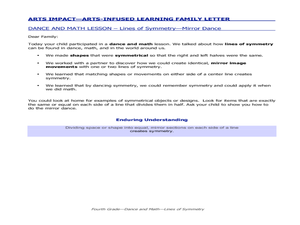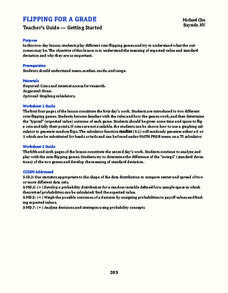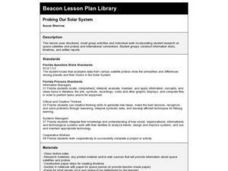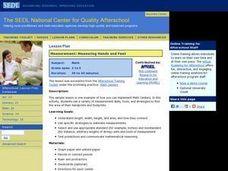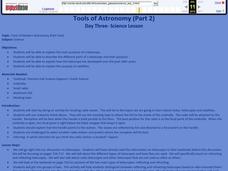Curated OER
Strange New Planet
Fourth graders gather data and simulate a Mars spacecraft mission using multi-sensory observations.
Curated OER
Lines of Symmetry - Mirror Dance
Fifth graders analyze how to divide space or shape into mirror sections to create lines of symmetry. In this lines of symmetry lesson, 5th graders discuss symmetry in dance, math, and living. Students participate in a dance warm-up and...
Curated OER
Flipping for a Grade
What happens when your teachers get tired of grading tests and want to use games of chance to determine your grade? How would you decide which game they should play? Learn how to use expected value and standard notation to compare two...
Curated OER
Sensing Energy: Designing to Stay Cool
Students examine the energy the sun produces on a daily basis. In groups, they discover the properties of visible and invisible light. They also adjust the exposure time to change the properties of various objects. To end the lesson,...
Polk Bros Foundation
A Way to Analyze Paragraphs to Figure Out the Main Idea of a Nonfiction Text
Shrink up a section by asking pupils to write down the main idea for each of seven paragraphs. There is a space provided for each main idea. When students have completed this portion, they write down what they think to be the central...
Curated OER
Protecting the Critical Habitat of the Manatee and the Loggerhead Turtle
First graders research Belize and its landscape and animals on the included internet sites. The students complete activities/centers across the curriculum utilizing the facts they discovered.
Curated OER
Transformations
Several practice exercises suitable for any geometry class working on transformation, symmetry, and tessellation -- especially visual representations of image translation, rotation, and reflection, symmetry, tessellations and tangrams --...
Curated OER
Rock This Party
Watch this video to learn the line dance steps that are performed to the song "Rock This Party" by Bob Sinclair. The written directions are a little confusing but after watching the video it all makes sense. This is a 32-count dance that...
Curated OER
Did You Know?
Learn about ants and printing in one fun worksheet! After you read some interesting facts about ants, practice writing the word ant on a tracing line. Then, draw a picture of an ant in a space provided.
Curated OER
Strawkets and Control
Students investigate the effect that fins have on rocket flight. They construct two paper rockets that they can launch by blowing through a straw, one with fins and one with wings, and observe and record the results of the rocket flights.
Curated OER
Listen and Learn
Second graders play in a listening game and brainstorm ways to communicate health information and ideas.
Curated OER
Destination Outer Space
Fourth graders use effective writing skills, their imagination, and their knowledge of the nine planets as they create travel pamphlets of the solar system.
Curated OER
Probing Our Solar System
Third graders engage in a lesson utilizing small group activities and individual work incorporating student research on space satellites, probes and international connections. They, in groups, construct information disks, timelines, and...
Curated OER
Be the Kiwi: History of New Zealand Part 2
Students discover details regarding the history of New Zealand. In this New Zealand history instructional activity, students complete a resource guide that requires them to conduct research to learn about the entire history of the nation.
Curated OER
Space Science:Wherever You Go, There You Are
Students explore navigation principles by observing, measuring, and interpreting data to determine locations. Using a compass, compass rose, and a transit, they plot courses and discover the workings of the Global Positioning System...
Math Learning Center
Grade 5 Supplement Set A2 – Number and Operations: Primes, Composites and Common Factors
Incorporate riddles into your math lesson by having students make tree factors and determine if the number is a prime or composite. They will also use other clues to find the answer to the riddle while sharpening their multiplication...
University of Colorado
Astro-Chronology
Class members play a version of the game Chronology to determine when certain scientific events occurred in history. Teams play until someone has 5-10 events in the correct order.
Laboratory for Atmospheric and Space Physics
Planetary Distances on the Playground
There's no need to stay inside; get out of the classroom and create a scaled map of the solar system on your playground field! In collaborative groups, scholars identify the distance between the sun and other planets, place planet...
Laboratory for Atmospheric and Space Physics
A Classroom Solar System
Create a scaled model of our solar system in your classroom! Scholars work collaboratively to build paper mache planets and hang them in their proper position to showcase each planet's location in the solar system.
Del Mar College
Formulas for Elementary and Intermediate Algebra
Give your scholars the support they need to work with formulas. A reference page offers definitions and picture examples of perimeter, area, surface area, volume, the Pythagorean theorem, a variety of shapes, and more.
Curated OER
Measurement: Measuring Hand and Feet
Here is a good lesson which invites learners to practice measurement using standard and nonstandard measuring tools. In this measurement lesson, learners work with length, width, height, and area. They use standard and nonstandard...
Facing History and Ourselves
Preparing Students for Difficult Converstaitons
Many of the issues facing 21st Century learners are challenging and even discussing these issues can be a challenge. So how do teachers prepare learners for these difficult conversations? How do instructors create a safe classroom where...
Curated OER
Tools of Modern Astronomy
Students differentiate refracting and reflecting telescopes. In this earth science lesson, students explain how they are closely connected to satellites. They complete the concept map at the end of the activity.
Curated OER
The Water Planet
Students use NASA photographs and hands-on activities to compare the amounts of land and water on our planet. They discover that the world has five oceans and that they cover seventy percent of Earth's surface. Students learn how this...


